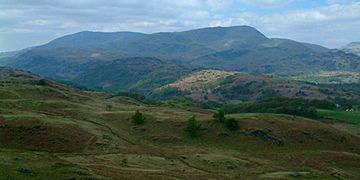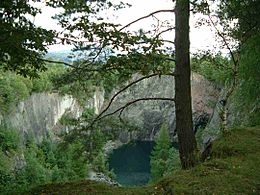Holme Fell facts for kids
Quick facts for kids Holme Fell |
|
|---|---|

|
|
| Highest point | |
| Elevation | 317 m (1,040 ft) |
| Prominence | 165 m (541 ft) |
| Parent peak | Old Man of Coniston |
| Listing | Marilyn, Wainwright |
| Geography | |
| Location | Cumbria, England |
| Parent range | Lake District, Southern Fells |
| OS grid | NY315006 |
| Topo map | OS Landranger 90, Explorer OL7 |
Holme Fell (sometimes spelled Holm Fell) is a small mountain, known as a fell, in the beautiful Lake District in Cumbria, England. It sits between Coniston Water and Little Langdale. This fell is almost completely surrounded by Yewdale Beck, which makes it feel separate from the larger Coniston Fells nearby.
Contents
Exploring Holme Fell's Landscape
Holme Fell is connected to Wetherlam, another fell, but the path between them is quite winding. To the east, the high ground continues towards Black Fell.
The Ridge and Its Peaks
Holme Fell itself is a long, narrow ridge that stretches for about one and a half miles from north to south. The highest point, or summit, is at the very southern end. This part is protected by steep cliffs called Calf Crags and Raven Crags.
Just north of the summit is another peak called Ivy Crag, which has a large pile of stones, known as a cairn, at its top. After Ivy Crag, the ground dips down into a hollow called Uskdale Gap. Further north, there are several smaller peaks that gradually get lower until you reach the final small hill called Great How. From there, the land drops quickly down to the valley of Little Langdale.
Paths and Surroundings
The edges of Holme Fell are marked by roads and paths, which are great for taking circular walks. The main road connecting Ambleside and Coniston is to the east. A smaller road along Little Langdale runs to the north. Yewdale Beck flows around the southern side of the fell, with a narrow lane leading to Hodge Close right beside it.
From Hodge Close, a bridleway (a path for horses and walkers) goes north to Little Langdale. The southern part of Holme Fell is covered in natural woodlands, mostly trees that lose their leaves in autumn. There are also some larger planted forests to the north.
Quarry Reservoirs and Yew Tree Tarn
You can find the remains of old quarries at Hodge Close and Uskdale Gap. To the west of Uskdale Gap, there are two small tarns (mountain lakes). These were built as reservoirs to supply water for the quarry. The water was used to power a special lift, called a funicular, which helped bring slate up to ground level.
Another man-made lake is Yew Tree Tarn, located next to the Ambleside-Coniston road. This tarn was created in the 1930s by James Marshall, the landowner, who built a dam to make it 10 feet (3 meters) deep. He wanted to create a good spot for fishing, and today, there are still many trout there.
Climbing Holme Fell
You can climb Holme Fell using several different paths. Popular starting points include Holme Ground, Hodge Close quarry, Yew Tree Tarn, and Yew Tree Farm. The routes from Yew Tree Tarn and Yew Tree Farm can easily be extended to include a visit to the popular Tarn Hows.
Views from the Summit
Even though Holme Fell is not a very tall mountain, its isolated location means it offers fantastic views. You can see far to the north, south, and east. This includes almost the entire length of Coniston Water. The larger Wetherlam and the rest of the Coniston fells block the distant views to the southwest.
What's in a Name?
There's a bit of a debate about how to spell the name of this fell! The Ordnance Survey Explorer map, which is very detailed, shows it as Holme Fell. However, their larger Landranger map spells it Holm Fell, even though a place nearby is called Holme Ground. The Ordnance Survey's official list of places only records Holme Fell, suggesting the Holm Fell spelling might be a mistake on their map.
Both Alfred Wainwright, a famous fell walker and author, and Alan Dawson, another author, use different spellings in their books. Wainwright uses Holme Fell, while Dawson uses Holm Fell.
No matter how you spell it, the word holm(e) is thought to come from an Old Norse word. It likely referred to a dry piece of land found within a marshy or wet area.
Hodge Close Quarry: A Place for Adventure
On the slopes of Holme Fell, you'll find the huge, no-longer-used green slate quarry called Hodge Close. This quarry closed just before the Second World War.
Today, Hodge Close Quarry is a popular spot for adventure. Its flooded chambers and tunnels are used by cave divers who explore underwater. It's also a fantastic place for rock climbers, offering some challenging routes like 'First Night Nerves' and 'Wicked Willie'.




